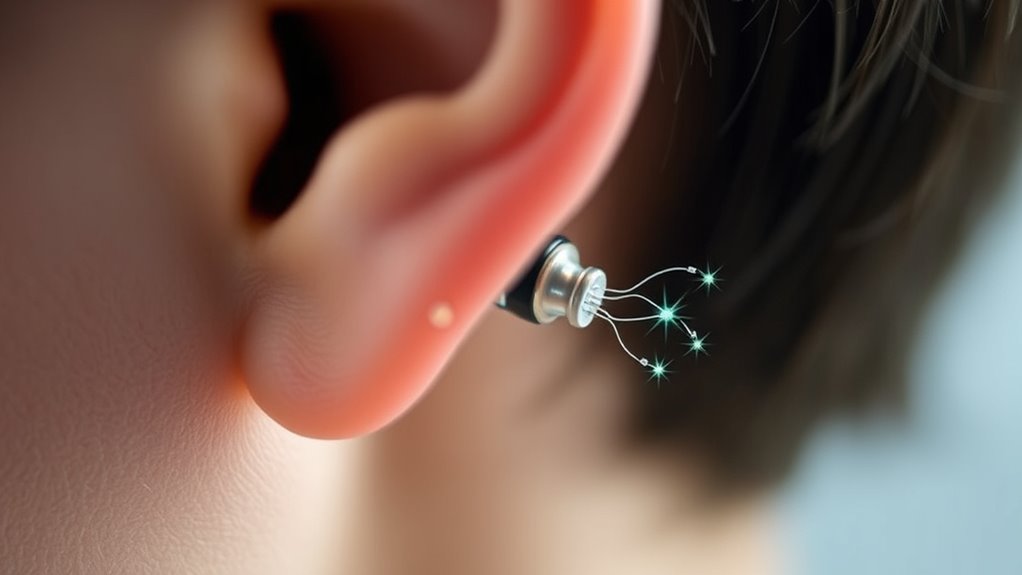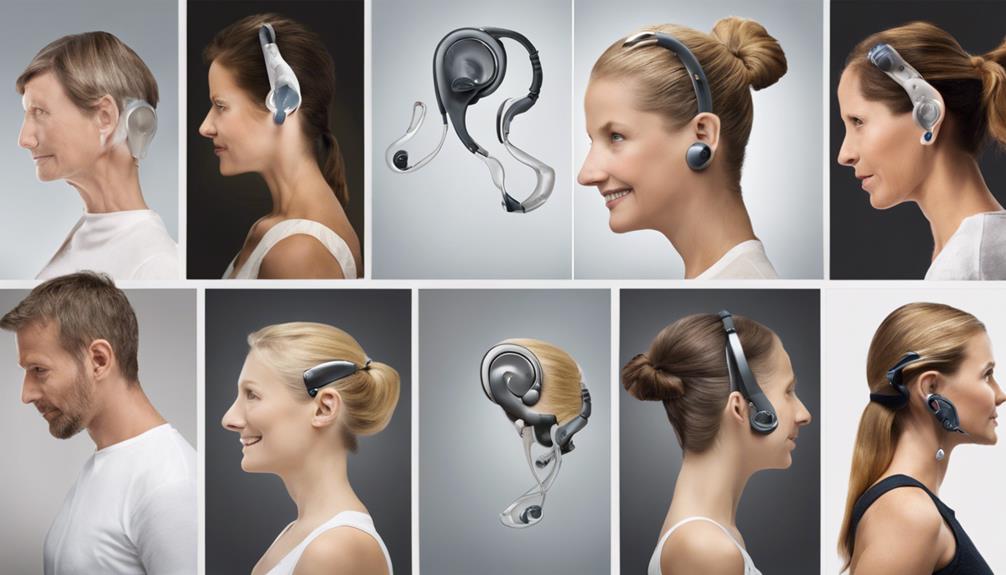You hear through a cochlear implant by first capturing sound with a microphone inside the external device. The sound is then processed into digital signals by a processor that improves clarity and broadens the sound spectrum. These signals are transmitted wirelessly to the internal implant, where an array of electrodes inside your cochlea delivers precise electrical impulses to your auditory nerve. This process mimics natural hearing, and if you keep exploring, you’ll discover how each component works together seamlessly.
Key Takeaways
- Sound is captured by the external microphone and converted into digital signals by the processor.
- The processed signals are transmitted via the transmitter coil to the internal implant.
- The internal electrode array stimulates the auditory nerve with precise electrical impulses.
- These electrical impulses bypass damaged cochlear hair cells to mimic natural sound signals.
- The brain interprets the electrical signals as recognizable sound, enabling hearing perception.

Cochlear implants are advanced devices designed to help people with severe hearing loss or deafness regain a sense of sound. When you consider hearing loss management, these devices stand out as a groundbreaking solution that restores auditory perception by bypassing damaged parts of your ear. Instead of relying solely on traditional hearing aids, cochlear implants use cutting-edge implant technology advancements to directly stimulate the auditory nerve, allowing you to perceive sound in ways you might not have thought possible.
Cochlear implants restore sound by directly stimulating the auditory nerve, bypassing damaged ear parts for improved hearing.
The process begins when sound enters your ear and is captured by a microphone built into the external component of the implant. This sound is then converted into digital signals through a sophisticated processor, which interprets the auditory information and prepares it for further transmission. Thanks to recent implant technology advancements, these processors are now smaller, more efficient, and capable of distinguishing a wide range of sounds with remarkable accuracy. This means you can now experience clearer speech, even in noisy environments, and enjoy a broader spectrum of sounds like music and environmental noises.
Once the sound is processed, the signals are sent via a transmitter coil placed on your scalp to the internal component of the cochlear implant. Inside your cochlea—a spiral-shaped part of your inner ear—the device consists of an array of electrodes. These electrodes are designed to stimulate the auditory nerve directly, bypassing the damaged hair cells that traditional hearing aids rely on. The implant technology advancements have enabled these electrodes to be more fine-tuned, allowing for more precise stimulation patterns that closely mimic natural hearing. Enhancements in electrode design have contributed to improved sound quality and speech recognition for users.
As electrical impulses are delivered to your auditory nerve, your brain interprets these signals as sound. Over time, with consistent use and auditory training, you’ll start to recognize familiar sounds and understand speech more easily. The entire process happens almost instantaneously, giving you real-time auditory feedback. The key to success with cochlear implants lies in effective hearing loss management, which includes ongoing audiological support, speech therapy, and adjustment of the device settings to optimize your hearing experience.
Frequently Asked Questions
How Long Does It Take to Adapt to a Cochlear Implant?
Adapting to a cochlear implant varies from person to person. You might experience sensory adaptation within a few weeks, but full adjustment often takes several months or even up to a year. Consistent therapy duration and practice are key to improving hearing. During this time, your brain learns to interpret new sounds, so patience and regular therapy sessions help speed up your adaptation process, making it easier to enjoy improved hearing.
Are Cochlear Implants Suitable for All Types of Hearing Loss?
Imagine a device that transforms sound into electrical signals, but it’s not suitable for everyone. Cochlear implants are typically designed for those with severe to profound hearing loss, making surgical candidacy essential. While they offer hearing aid compatibility for many, they aren’t ideal for all types of hearing loss, especially mild or conductive. You should consult an audiologist to determine if you’re a good candidate for this life-changing technology.
What Is the Cost of Cochlear Implantation?
The cost of cochlear implantation varies depending on implant cost factors like device type, surgical fees, and post-op therapy. You might find cochlear implant financing options available through insurance, government programs, or payment plans. On average, expect costs between $30,000 and $50,000 per ear. It’s important to consult with your healthcare provider and insurance company to understand coverage and financing options tailored to your needs.
Can Cochlear Implants Be Upgraded or Repaired Easily?
You might wonder if cochlear implants can be upgraded or repaired easily. Generally, the device durability varies, and some parts can be fixed or replaced if needed. However, upgrades often require professional assessment and may involve replacing external components or software updates. The upgrade process isn’t always straightforward, but your audiologist can guide you through it to ensure your implant continues to perform well and meet your hearing needs.
Do Cochlear Implants Affect Other Medical Devices or MRI Scans?
Back in the days of dial-up internet, concerns about magnetic interference seemed outdated, yet they’re still relevant today. When it comes to MRI safety, cochlear implants can be affected by magnetic interference, potentially disrupting the scan or damaging the device. You should always inform your healthcare provider about your implant, so they can take precautions or adjust the MRI settings to minimize risks and guarantee safe imaging.
Conclusion
You might believe cochlear implants simply translate sound into electrical signals, but recent research suggests they also tap into the brain’s plasticity, rewiring how you perceive sound over time. Some theories propose that this adaptability enhances hearing beyond the device’s basic function. While the core technology converts sound into impulses, the brain’s response adds a layer of complexity, making cochlear implants not just a tool for hearing but a remarkable example of neuroplasticity in action.











